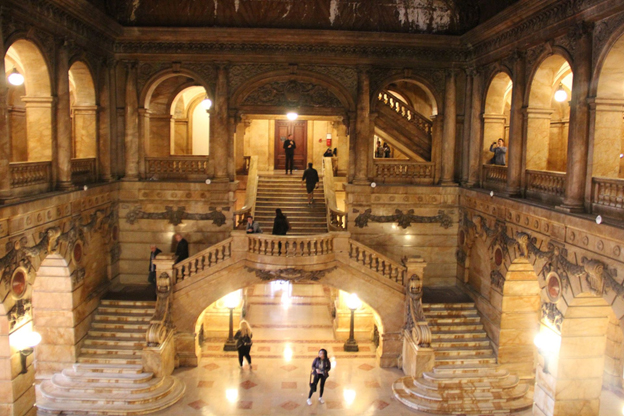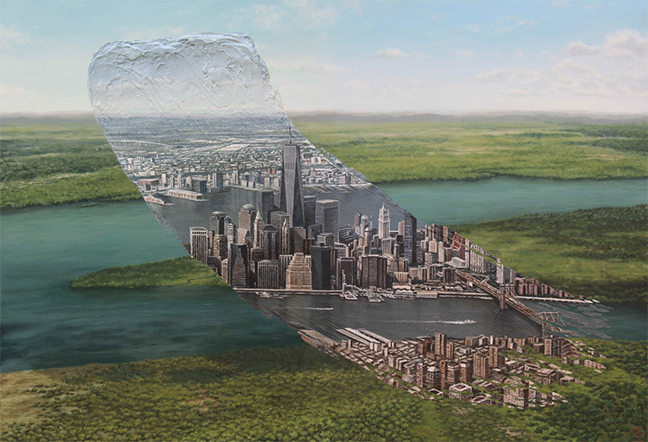I went down to the Surrogate’s Courthouse on Chambers Street to check out an exhibit called New Visions of Old New York, which promised an interactive 3-D map of New Amsterdam. Spending a little time in the 17th century seemed like a great idea here in the 21st, which is feeling more and more like Act I of King Lear: a massive machinery of deceit, hubris and revenge being set in motion (but without the poetry). During this cold, cold winter I was also looking for reasons to have faith that the great—if deeply flawed—democratic project of the United States won’t collapse and bring down the entire world order with it.
This, I know, was asking a lot of an exhibit, especially one that turned out to fit in one small back room and that features a soundscape so modest that at first I mistook the gently evocative noises of boats bobbing on water for a noisy humidifier. The show is a collaboration between the City’s Department of Records and Information Services (DORIS), which operates the City’s Municipal Archives, and the New Amsterdam History Center. It definitely achieves the goal of highlighting their holdings, which include tens of thousands Dutch documents dating from as early as 1636. Speaking of Shakespeare, that’s only 20 years after his death.

The show zeroes in on the role of women, enslaved people and Native Americans during the brief era when the Dutch West India Company ruled the tiny enclave below the wall that gave Wall Street its name. Once I adjusted to the lack of razzle-dazzle museum design, I realized I was looking at reproductions of some astounding documents.
First up was a peek at the life of Lady Deborah Moody of Gravesend Brooklyn. I’d come across her before, and still can’t fathom why she’s not a household name. A religious dissenter who fled England and was expelled from Massachusetts for being a “dangerous woman,” she was not just the first female landowner in the new world, but the first to found a settlement—in 1645, no less.
The show then explores trade, theorizing that the success of New York City derives from its takeover of the downtown Native American trading center that had already been thriving for centuries. Whale hunters came from Long Island, merchant ships from Europe, pirates from everywhere, and of course, that most horrifying form of trade: slave ships from Africa. Once again a woman, one even more obscure than Lady Moody, seems to have been the mover and shaker: one Sarah Kierstede, described as a trusted interpreter between the Dutch and the respected local sachem, Chief Oratam of the Hackensack Lenni Lenape tribe. In a document from 1656, Peter Stuyvesant designated a regular time and place (in front of the Kierstede home) expressly for the convenience of all these parties traveling to New Amsterdam to trade their pelts, venison, corn and firewood—the progeniture of the Saturday Greenmarket.
Just as I began to wonder what the Native Americans made of this strange European business of writing things down on pieces of parchment, the exhibit confirmed my worst suspicions. A deed from 1657, in gorgeous Dutch penmanship, transferred ownership of all of Staten Island from the local tribe to one Henrick van der Capelle tho Ryssel. In the blown-up reproduction, you can clearly see the marks two of the native parties made in lieu of signatures. Not sharing the European concept of permanent land ownership, they clearly did not understand what they were signing away in perpetuity with a triangle and a bird claw. In exchange they were granted a random collection of goods including “some awls,” 10 muskets and 30 pairs of Faroese stockings.
Another disturbing document, from 1644, granted release to some dozen enslaved men after 19 years of servitude to the Dutch West Indian Company. They were given a plot of land north of the settlement known as “the land of the blacks,” and were expected to turn over an annual share of their harvest. I was pleased to see that their wives were included in the deed, until I saw that their children were not.
I saved the 3-D interactive map, the contribution of the New Amsterdam History Center’s Mapping Early New York project, for last. It’s on a large wall-mounted screen. You can touch various downtown locales, and the “camera” will swoop across a simulation of lower Manhattan and gradually zoom in on the site: the House of Enslaved Workers, the Stadt Huys or city hall, the Stuyvesant House, Fort Amsterdam and more, each with an explanatory panel. It all feels a little quaint and low budget. Someone meticulously created shadows for each person and animal and smoke actively rising from every chimney and pipe, but on close inspection you can tell that the figures are only 2D.
Still, the simulations left a strong impression on me. How pristine the southernmost triangle of what was known in the Munsee language as manaháhtaan! With only a cluster of buildings no higher than two stories, how uninterrupted the views, how sparkling the waters and sandy the shore. The wide dirt precursor to Broadway, pre-Bowling Green, was charmingly lined with Dutch-style homes, livestock pens and a windmill. The huge, well-tended Company garden, on the site of present-day Tribeca, was fecund with fruit trees and pumpkin patches.
But the more I looked, the more I found myself not fully buying this idyllic settlement. I found myself scouting for squalor in this pre-plumbing era of slave labor, livestock manure and constant wars with the Lenni Lenape. I felt better when the camera zoomed in on an East River dock and one of the brick warehouses at least had a loose shutter. In my favorite simulation, a quick gondolier’s-eye view across one of two Dutch canals, dotted with quaint wooden bridges above, the text does at least mention the ongoing issues of backed-up sewage and storms knocking out the canal walls.
It suddenly hit me that, with the exception of some saplings on the rolling hills north of the wall, there were no trees; the Dutch had cut them all down for lumber and fuel. Correction from one of the wall panels: enslaved Blacks did the forest clearing. Tulip trees, with their long straight trunks, were especially prized because they were perfect for mishoons (canoes), like the ones that conveyed the Long Island whale hunters to market.
I touched “The Wall” for one last look. The screen froze. I reported it to someone in the adjoining office, and a guy came to reboot the computer. I watched the familiar, tedious process: typing of the password, the dreaded “no signal,” the trying again and hoping for better luck. It made me want to hoe a pumpkin patch beside the Hudson River. It made me want to reread Pete Hamill’s novel Forever, whose infinitely richer sensory picture of Manhattan history through the ages isn’t dependent on ConEd or Microsoft.
On my way in to the grand Beaux Arts courthouse built in 1907, I had stopped to admire the lobby, a triple-height fairyland of carved marble arches, staircases, garlands, entablatures and balustrades, one you’ve seen in many movies and TV shows. Workers were busy setting up a fancy dinner party, and I had to step over bundles of cords.
By the time I left, a gigantic computer screen had been mounted and would no doubt be spewing techno pop in a few hours. It was flashing a vertigo-inducing pattern of shifting acid green lines, jarring against all the yellow Siena marble.
Here we have it, I thought, the history of human endeavor: the tiny handmade timber, stone and brick enclave from the short Dutch reign; this glorious building from the heyday of great civic architecture; and slithering acid green lines on a giant screen from the present, just because.
What was my takeaway? I walked out feeling grateful to be able to roam freely among these three ages, and gave thanks to the very old technology of pieces of paper carefully preserved for centuries by archivists’ hands. I felt grateful for the dedicated, underfunded government work force being callously decimated. I kept rolling the term “civic pride” over in my mind, wishing it were still a going concern.
Top Photo: There was once a stand of hickory trees in Lower Manhattan known in Lenape as Manaháhtaan –
the place where wood is gathered to make the bows. Pictured: Human Nature by David Ambarzumjan.
(courtesy @decolonialatlas)




